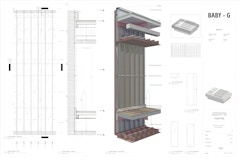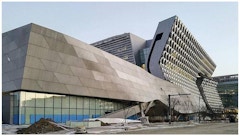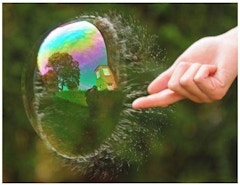363 results
-
 The iconic building principal incentive is to be visually attractive or stand out, for this purpose three main features must be accomplished: have a…
The iconic building principal incentive is to be visually attractive or stand out, for this purpose three main features must be accomplished: have a… -
Design Considerations and the Complex Facade
- Paper by Stan Su
The design of complex, high-performance facades involves balancing attention towards principles of material selection, thermal and moisture
-

Mixed Reality in Facade Education
- Paper by Phillip Anzalone AIA · Amber Bartosh, RA LEED AP BD+C
Developments in performative computational analysis, mass customization, and complex form manipulation revolutionized building envelope design
-

Multi Layer Facades
- Paper by Robert Moisy
The history of high performance facades and glazing has been a tale of attempting to manage the conflicting requirements of, on one hand inviting
-
Creating Transformational Geometry
- Paper by Tom Peterson, System Designer Manager Austin Bensend, PE, SE, Director - Design Engineering
Over the past two decades, the art of cold-forming glass has grown from an unknown approach to a widely accepted strategy for achieving an array of… -

Building Scale Mock-up
- Paper by Michael Martinez, Associate Asim Tahir, District & Renewable Energy Lead
Until recently, Google has occupied buildings that were designed for others and modified the interiors to suit its needs. Many of the improvements… -

Facade Tectonics Forum: NYC
- Event by Facade Tectonics Institute
FTI's half-day NYC Forum will take place virtually on Thursday, November 5, 2020, hosted by the Ornamental Metal Institute of New York. Join us for this year’s virtual event themed Pandemic Pantry: Digesting Covid-19 and Understanding the Lessons for Building and Facade Systems..
-

-
Blast Performance
- Paper by Jon Kimberlain · Jie Feng · Will Wholey · Dan Aggromito · Valérie Hayez
Designing for blast performance for glazing units can be very complex. The test methods for evaluating performance include subjecting units to actual
-

Glass Spandrels and Shadow Boxes
- Paper by John Jackson
Glass spandrels are a common design strategy utilized to opacify floor levels in building facades. These opaque glass assemblies are integrated into
-
Behind the Surface
- Paper by Damon Caldwell
The architectural facade, like clothing for a building's form, serves as both an aesthetic expression and a protective veil, concealing the inner
-
Subjective Perception and Objective Measurement
- Paper by Caroline Lama · Antonio Luz · Ashley Reed
Current glass industry standards provide clear tolerances for readily quantifiable physical properties to assist with the evaluation of visual
-

-

-

-

Case Study: Kao Ho Hospital Development, Kaohsiung, Taiwan
- Paper by Jerry Ma · Jason JS Lin
U-shaped annealed profiled glass, or U channel glass is used in both the interior and exterior glass façade for decades, as it has long and durable
-

Modeling Megapanels
- Paper by Elizabeth Bishop, AIA, LEED AP · Emily Green, NCARB, LEED GA · Lisa Podesto, PE
Large format, steel-stud framed “megapanel” facades with rainscreen cladding create uniquely complicated requirements for digital documentation and
-

Novel Active Facade Systems and Their Energy Performance in Commercial Buildings
- Paper by Ajla Aksamija · Mahsa Farid Mohajer · Zlatan Aksamija
This article presents results of a research study that focuses on understanding energy performance of novel facade systems that integrate
-

Systems Thinking
- Paper by Gabrielle Brainard, AIA, LEED AP, CPHC
This paper surveys facade design education in accredited Bachelor and Master of Architecture (B.Arch and M.Arch) programs in the United States. A
-

Developments in Gridshell Design
- Paper by Cristobal Correa P.E. · Craig Schwitter P.E.
In 1959 Heinz Isler challenged the world of concrete shell design by proposing a series of shapes for shells that were very different from what most

